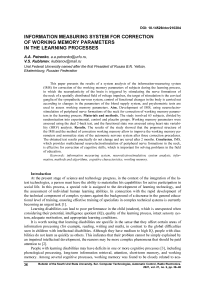Information measuring system for correction of working memory parameters in the learning processes
Автор: Petrenko A.A., Kublanov V.S.
Рубрика: Инфокоммуникационные технологии и системы
Статья в выпуске: 2 т.21, 2021 года.
Бесплатный доступ
This paper presents the results of a system analysis of the information-measuring system (IMS) for correction of the working memory parameters of subjects during the learning process, in which the neuroplasticity of the brain is triggered by stimulating the nerve formations of the neck of a spatially distributed field of voltage impulses, the target of stimulation is the cervical ganglia of the sympathetic nervous system, control of functional changes in the body is carried out according to changes in the parameters of the blood supply system, and psychometric tests are used to assess working memory parameters. Aim. Development of IMS, using neuroelectrostimulation of peripheral nerve formations of the neck for correction of working memory parameters in the learning process. Materials and methods. The study involved 65 subjects, divided by randomization into experimental, control and placebo groups. Working memory parameters were assessed using the dual 2-back test, and the functional state was assessed using heart rate variability (HRV) analysis. Results. The results of the study showed that the proposed structure of the IMS and the method of correction working memory allow to improve the working memory parameters and normalize state of the autonomic nervous system after three correction procedures. The obtained test results practically do not change and are saved after 2 months. Conclusion. IMS, which provides multichannel neuroelectrostimulation of peripheral nerve formations in the neck, is effective for correction of cognitive skills, which is important for solving problems in the field of education.
Information measuring system, neuroelectrostimulation, system analysis, information, methods and algorithms, cognitive characteristics, working memory
Короткий адрес: https://sciup.org/147233814
IDR: 147233814 | УДК: 303.732.4 | DOI: 10.14529/ctcr210204
Список литературы Information measuring system for correction of working memory parameters in the learning processes
- Nalichaeva S.A. Psihologiya stressa [Psychology of stress]. Sevastopol, Avangard Publ., 2018. 97 p.
- Gupta P.K., Sharma V. Working Memory and Learning Disabilities: A Review. The International Journal of Indian Psychology, 2017, vol. 4 (4), pp. 111-121. DOI: 10.25215/0404.013
- Masoura E.V. Establishing the link between working memory function and learning disabilities. Learning disabilities. A contemporary journal, 2006, vol. 4 (2), pp. 29-41.
- Swanson H.L., Howard C.B., Saez L. Do different components of working memory underlie different subgroups of reading disabilities? Journal of learning disabilities, 2006, vol. 39 (3), pp. 252-269.
- Alloway T.P. Working memory, but not IQ, predicts subsequent learning in children with learning difficulties. European Journal of Psychological Assessment, 2009, vol. 25 (2), pp. 92-98. DOI: 10.1027/1015-5759.25.2.92
- Lebedev A.V., Zhigalov Yu.A. Psihicheskie processy i sostoyaniya [Mental processes and states]. St. Petersburg, 1999. 124 p.
- Mandel' B.R. Sovremennaya pedagogicheskaya psihologiya [Modern educational psychology]. Moscow, Direkt-Media Publ., 2015. 828 p.
- Brain Waves Module 2: Neuroscience: implications for education and lifelong learning. The Royal Society, 2011.
- Kublanov V.S. [Electrophysical method for correcting violations of the cerebral blood supply regulation system]. Biomedical Radioelectronics, 1999, no. 4, pp. 12-15. (in Russ.)
- Akulov S.A., Fedotov A.A. Osnovy teorii biotekhnicheskih sistem [Foundations of the theory of biotechnical systems]. Moscow, Fizmatlit Publ., 2014. 259 p.
- Popechitelev E.P. Chelovek v biotekhnicheskoj sisteme [Human in biotechnical system]. Staryy Oskol, TNT Publ., 2016. 584 p.
- Ershov Yu.A., Shchukin S.I. Osnovy analiza biotekhnicheskih sistem [Fundamentals of the analysis of biotechnical systems]. Moscow, Publishing house of Bauman Moscow State Technical University, 2011. 526 p.
- Kublanov V.S., Babich M.V., Petrenko T.S. New principles for the organization of neurorehabilitation. Biomedical Engineering, 2018, no. 52, pp. 9-13.
- Rizzo D.C. Fundamentals of anatomy and physiology. Boston, USA, Cengage Learning, 2015. 562 p.
- Kublanov V., Aftanas L., Petrenko T., Danilenko K. Investigation of the Neuro-electrostimu-lation Mechanisms by Means of the Functional MRI: Case Study. Proceedings of the 11th International Joint Conference on Biomedical Engineering Systems and Technologies, 2018, vol. 4, pp. 319-324. DOI: 10.5220/0006712203190324
- Pelegrina S., Lechuga M.T., García-Madruga J.A., Rosa Elosúa M. Normative data on the n-back task for children and young adolescents. Front. Psychol., 2015, vol. 6: 1544, pp. 1-11.
- Jaeggi S., Studer-Luethi B., Buschkuehl M., Su Y. The relationship between n-back performance and matrix reasoning - implications for training and transfer. Intelligence, 2010, vol. 38, no. 6, pp. 625-635.
- Ruf S.P., Fallgatter A.J., Plewnia C. Augmentation of working memory training by transcranial direct current stimulation (tDCS). Sci. Rep., 2017, vol. 7 (1), no. 876, pp. 1-11.


